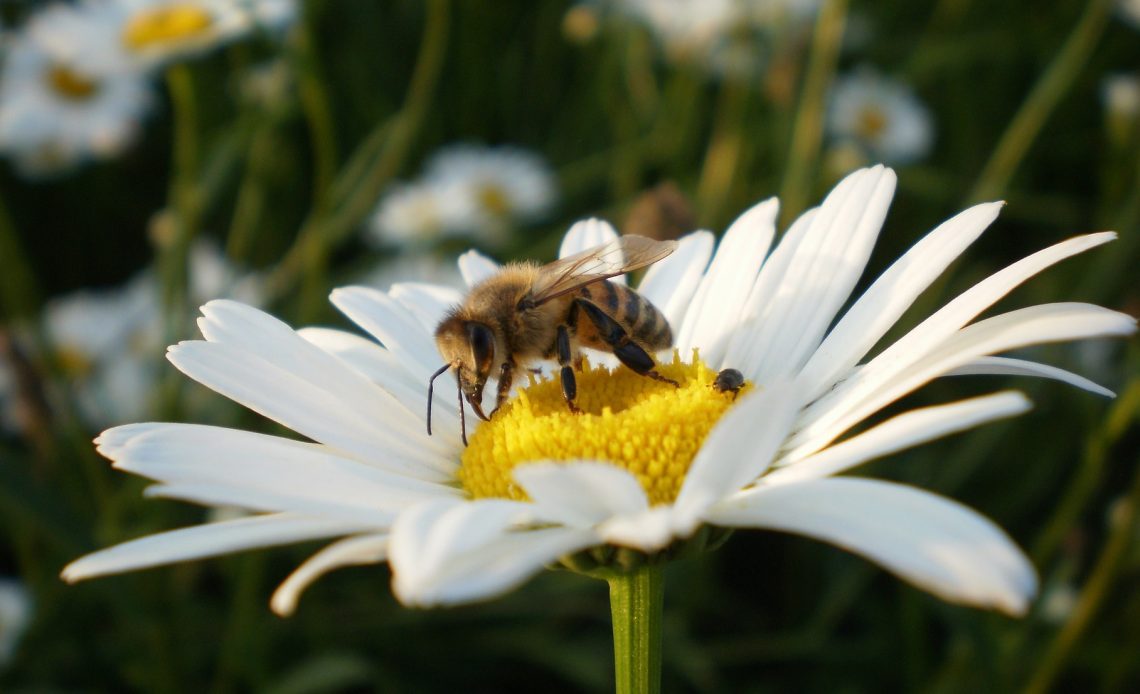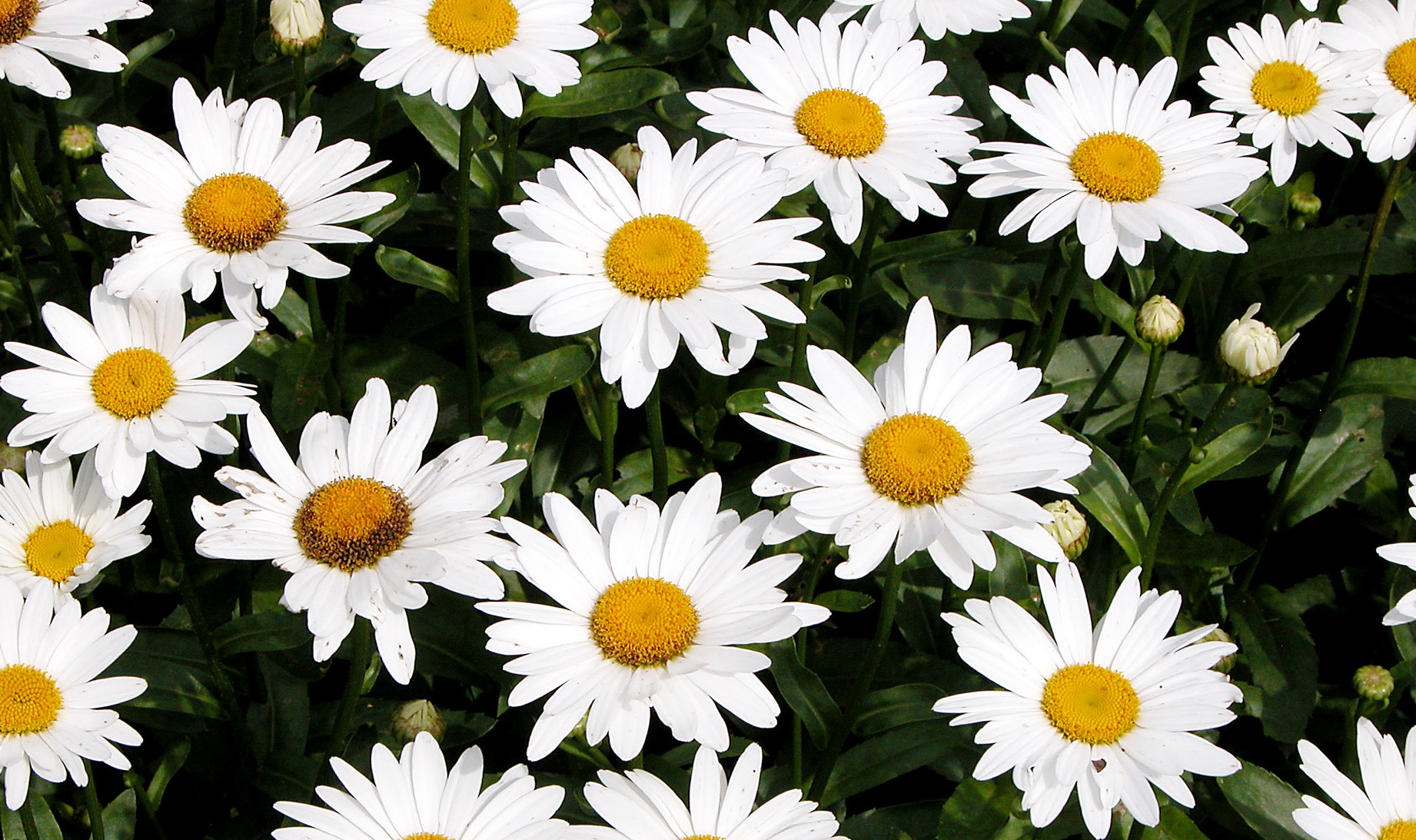

We’re here to help! Wild Yards is a completely free website that is 100% dedicated to helping you create a wildlife-friendly, sustainable yard. Read more
WildYards is reader-supported. When you buy a product through a link on our site, we may earn a comission. Every product is independently selected by our (obsessive) editors and our reviews are unbiased and objective. Read more about our mission or our privacy policy.
Bees need our help now more than ever. They’re disappearing at an alarming rate due, in part, to the lack of crop diversity. Fortunately, you can help your local bees by planting more of their favorite flowers in your backyard. Bees tend to prefer flat, open-faced flowers, like coneflowers and poppies. But do bees like daisies?
Bees love daisies! These flowers are easy for bees to find and they’re an excellent source of the pollen that bees so desperately need. Planting daisies provide bees with an additional food source that will encourage them to visit your garden.
Why do daisies attract bees?
One of the reasons why bees are always so busy is because, contrary to popular belief, they don’t like all flowers. Bees will go out of their way to track down the flowers they like best. What makes some flowers more appealing to bees than others? Well, a couple of things.
First and foremost, bees want flowers that have pollen and nectar. And they need that pollen and nectar to be easy for them to collect. Long, tubular flowers like trumpet vine, though popular with hummingbirds, don’t hold the bees’ attention for too long. The nutrients they have to offer are too hard to get to. Bees prefer shallow, flat flowers because they’re much easier for them to explore.
Second, bees need flowers that are brightly colored. They don’t see too well, so flowers that have a strong smell are also very appealing to them. Eye-catching, fragrant blooms are easier for bees to track down. The less time they spend hunting for flowers, the more time they can spend making honey and raising larvae back at the hive.
When you consider things from the bees’ perspective, daisies have got it all. And because they tick all the bees’ boxes, planting daisies in your garden is a great way to give these valuable pollinators a helping hand.
Do bees make honey from daisies?
Bees make honey from nectar. While daisies do provide bees with some nectar, they’re a far better source of pollen. So, it’s true that bees can use daisy nectar to produce honey, but it’s unlikely that you’ll find honey produced mostly from daisies.
However, daisies can help bees make honey, if only in an unrelated way. While nectar gives bees the quick energy they need to keep buzzing about, it’s not enough to keep them healthy. Pollen is what provides bees with the protein and fat that they need to survive. It’s a nutritious source of fatty acids, amino acids, and vitamins. And because pollen is the bees’ only source of protein (they don’t eat insects as wasps and hornets do), it’s critical to their survival.
Every bee needs pollen, young and old alike. If you ever get a chance to look closely at a worker bee, you may see a small yellow lump on its back legs. That’s where they store the pollen they collect from flowers, it’s called a “pollen basket”. Once the worker bee gets back to the hive, it will unload its pollen baskets.
At this point, the pollen is mixed with honey, nectar, and bee saliva to produce bee bread, which feeds the hive through winter. Bee bread is also used to feed young bees, supporting a new generation of worker bees for the next pollinating season. So, even though daisies may not be a part of the bees’ honey-making, they’re still an important part of the honey-making process!
Are bees attracted to all types of daisies?
Yes, bees can be attracted to all varieties of daisies (butterflies love them, too!). However, if you want to use daisies to attract bees, here’s a word of advice: stick with the classics. Not only are these daisies easy to find, but they’re also the ones with the most consistent track records for attracting bees.
Shasta daisies are just what you’d picture a daisy to look like. Bright white petals surrounding a large yellow center disk, Shastas grow in clumps about two feet wide by about three feet tall. They’re a welcoming, unpretentious yet eye-catching addition to any garden, and bees enjoy visiting them regularly.
You’ll also see success with oxeye daisies, which look very much like Shasta daisies but are a bit smaller, with more petals and a disk that’s slightly raised. Oxeyes grow wild in many parts of the U.S., so they’re easy to grow and even easier to take care of. Their wide availability also means many hives will enjoy pollinating them.
As with most flowers, bees tend to prefer daisies that have not been hybridized too much. Hybridized flowers are generally cultivated for ornamental blooms. And, even though they may offer prettier flowers, that’s often at the expense of the pollen and nectar that bees need.
With that in mind, avoid hybrid varieties like Gerbera daisies. Although these bold, brightly-colored flowers are sure to make a statement in your backyard, they’re just not popular with the bees. If you want more vibrant flowers in your backyard, but you still want to help your local bees, choose zinnias instead. They look a lot like Gerbera daisies, and bees just love them.

What’s the best way to use daisies to attract bees to your garden?
You’d be hard-pressed to find a daisy that your average honeybee would say no to. However, some bees may show a personal preference for one type of daisy over another. Male and female bees can have different tastes. You can never really predict just what your local hive will like best. So, to maximize your chances of using daisies to attract bees to your backyard, here are a few helpful tips.
Bees almost always prefer native species over ornamentals and other hybrids. So plant daisies that are native to your region if you can. This is also a great way to cut down on maintenance time. Planting native daisies mean the daisies are well-suited to your region’s growing conditions, and shouldn’t require much extra care to thrive. It’s a win-win for you and the bees.
Bees love to pick and choose from a selection of blooms. They like variety! So give it to them by planting multiple daisy cultivars in your bee garden. You can also plant your daisies with a handful of other bee-friendly flowers. Bee balm, goldenrod, and lavender are just a few favorites that can also help bring more bees to your garden.
If you plant daisies in your garden, you’ll have a hard time keeping the bees away! These easy-to-grow flowers are the perfect way to perk up your backyard and show your local hive some love at the same time.
